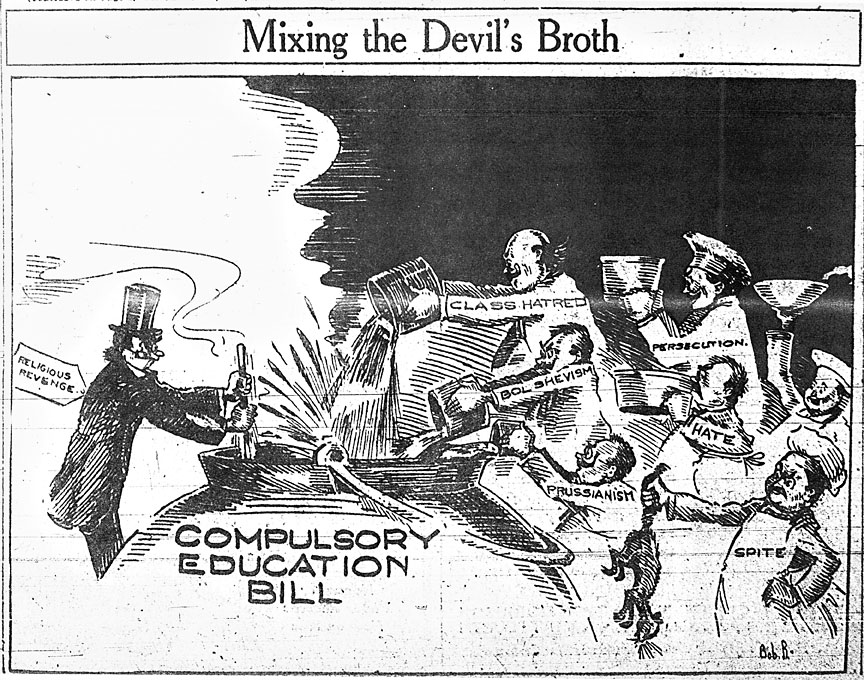Overview
Pierce vs. Society of Sisters, by Robert Bunting
The Compulsory Public School Attendance Bill was an initiative to amend the Compulsory Education Act that compelled children between the ages of eight and sixteen to attend public schools. Inaugurated by the Scottish-rite Masons of Oregon, the initiative measure appeared on the November 7, 1922, Oregon ballot.
Proponents of the measure—including the Ku Klux Klan and the Federation of Patriotic Societies—believed that the measure was necessary to preserve and perpetuate a homogeneous American culture. Opponents argued that the measure not only violated constitutionally guaranteed property rights but also posed a threat to religious freedom and the ability of parents to educate their children in accordance with their faith and conscience. Those most opposed to the measure were Roman Catholics, the initiative’s main target, and Seventh-Day Adventists, Episcopalians, and Lutherans—religions that operated private schools.
The Roman Catholic archbishop of Portland, Alexander Christie, immediately founded the Catholic Civic Rights Association of Oregon to combat the initiative and anti-Catholicism generally through pamphlets, newspaper articles, and lectures. In addition, the Oregon episcopacy asked pastors of the 130 Catholic parishes in Oregon to educate voters about the measure and to encourage Catholics to vote.
Content Standards
- HS.1 Analyze the impact of constitutional amendments on groups, individuals, institutions, national order.
- HS.4 Examine institutions, functions and processes of United States government.
- HS.6 Examine the institutions, functions, and processes of Oregon's state, county, local and regional governments.
- HS.7 Analyze political parties, interest and community groups, and mass media and how they influence the beliefs and behaviors of individuals, and local, state, and national constituencies.
- HS.65 Identify and analyze the nature of systemic oppression on ethnic and religious groups, as well as other traditionally marginalized groups, in the pursuit of justice and equality in Oregon, the United States and the world.
- HS.67 Evaluate historical sources for perspective, limitations, accuracy, and historical context.
- HS.68 Select and analyze historical information, including contradictory evidence, from a variety of primary and secondary sources to support or reject a claim.
- HS.69 Create and defend a historical argument utilizing primary and secondary sources as evidence.
Additional Sources
Bunting, Robert. "Pierce vs. Society of Sisters" The OE
Abrams, Paula. Cross Purposes: Pierce v. Society of Sisters and the Struggle over Compulsory Public Education. Ann Arbor: The University of Michigan Press, 2009.
Holsinger, M. Paul. "The Oregon School Bill Controversy." Pacific Historical Review 37:3 (Aug. 1968): 327-341.
Toy, Eckard. "Ku Klux Klan." The OE
“Portals of the Nation’s Future Free Public Schools.” Morning Oregonian, November 6, 1922, p. 6. Persistent Link
“The School Monopoly Bill has a Misleading Name!” The Maupin Times, October 19, 1922. Persistent Link
Cite
The Oregon Encyclopedia. "Mixing the Devil's Broth": The Compulsory Education Act of 1922. 2020. Retrieved from The Oregon Encyclopedia, http://oregonhist-oep-dev.azurewebsites.net/packets/1. (Accessed October 26, 2025.)Teacher Guide
1) Have students read and analyze the "Devil's Broth" political cartoon from 1922 and the "Advertisement, Vote 314 x Yes" from 1922. According to the supporters of each document, what are the arguments for and against the Compulsory Education Act? (H.S. 60). Ask students how these documents use facts, opinion, stereotypes, and persuasion to argue their case (H.S. 58).
2) Have students analyze the following documents: KKK meets with Portland Leaders, 1921 photo; The Truth About the KKK , 1921 flyer; Portland KKK, 1922, photo. How did the Scottish Rite Masons and the KKK influence political, community, and religious leaders to support their political agenda and beliefs in Oregon? Provide specific examples (H.S.30).
3) Have students analyze the following documents: Proclamation Against the KKK, 1922; From W.R. Burner to Governor Olcott, 1923; State of Oregon vs. Hill Military Academy, 1925. These documents represent the concerns political and judicial leaders had about the Ku Klux Klan and its plan to eliminate private schools. What arguments do they use to oppose the Compulsory Education Act?

